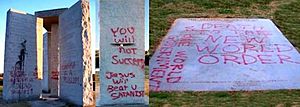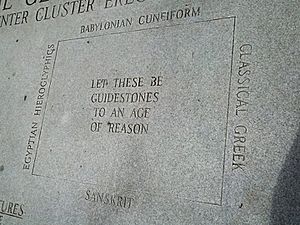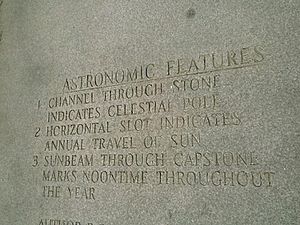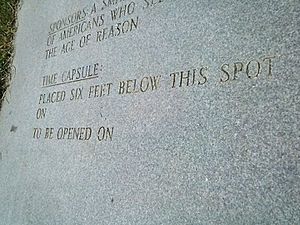Georgia Guidestones facts for kids
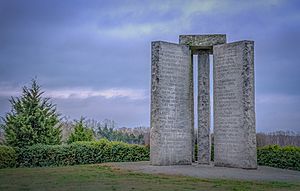
North view
|
|
| Coordinates | 34°13′55″N 82°53′40″W / 34.23194°N 82.89444°W |
|---|---|
| Location | Elbert County, Georgia, US |
| Material | Granite |
| Height | 19 ft 3 in (5.87 m) |
| Opening date | March 22, 1980 |
The Georgia Guidestones were a large monument made of granite stone. They were built in 1980 in Elbert County, Georgia, in the United States. This mysterious structure had ten important messages carved into it. These messages were written in eight different modern languages. A shorter message was also carved at the very top in four ancient languages.
The monument stood about 750 feet (230 m) (229 meters) above sea level. It was located about 90 miles (140 km) east of Atlanta, Georgia. Many people called it an "American Stonehenge" because of its large stones and mysterious purpose. The Guidestones were 19 feet 3 inches (5.87 m) tall. They were made from six huge granite slabs that weighed a total of 237,746 pounds (107,840 kg).
One stone slab stood in the middle, with four others placed around it. A large stone cap sat on top of these five slabs. These stones were set up to align with the stars and the sun. Another stone tablet was placed on the ground nearby. This tablet shared some facts about the monument's history and its goals. The people who created the Guidestones wanted to remain unknown. Their ideas about how people should live and organize the world made the monument a topic of much discussion and many conspiracy theories.
Contents
History of the Georgia Guidestones
How the Monument Was Commissioned
In June 1979, a man who used the fake name R. C. Christian contacted a company called Elberton Granite Finishing Company. He said he represented "a small group of loyal Americans." He asked the company to build the monument.
Christian explained that the stones would work like a compass, a calendar, and a clock. He also said they should be strong enough to last through "catastrophic events." Joe Fendley, who worked at the granite company, thought Christian was a bit strange. He tried to make Christian change his mind by giving a very high price for the project. This price was much higher than any job the company had ever done before.
To Fendley's surprise, Christian agreed to the high cost. When they talked about payment, Christian mentioned that his group had been planning the Guidestones for 20 years. He stressed that they wanted to stay anonymous.
Building and Unveiling the Stones
R. C. Christian gave the company a small model of the Guidestones. He also provided ten pages of detailed instructions. On October 1, 1979, Christian bought the 5-acre (2-hectare) of land where the monument would stand. He bought it from a farmer named Wayne Mullinex. Mullinex and his children were given the right to let their cattle graze on the Guidestones site for their whole lives.
On March 22, 1980, the monument was officially shown to the public. Between 100 and 400 people came to see it. Later, Christian gave ownership of the land and the Guidestones to Elbert County.
Vandalism and Damage
Over the years, the Guidestones were sometimes damaged. In 2008, people used polyurethane paint and wrote graffiti on the stones. Some of the messages included "Death to the new world order." Wired magazine reported that this was "the first serious act of vandalism" in the monument's history.
In September 2014, an employee from the Elbert County maintenance department called the Federal Bureau of Investigation (FBI). This was because the stones had been vandalized again with graffiti. One message said, "I Am Isis, goddess of love."
Messages on the Stones
The Ten Guidelines
The Georgia Guidestones had ten important messages carved into them. These messages were written in eight different modern languages. Each of the four large upright stones had two languages on its faces. If you walked around the monument clockwise starting from the north, you would see these languages: English, Spanish, Swahili, Hindi, Hebrew, Arabic, Traditional Chinese, and Russian.
Here are the ten guidelines:
- Maintain humanity under 500,000,000 in perpetual balance with nature.
- Guide reproduction wisely — improving fitness and diversity.
- Unite humanity with a living new language.
- Rule passion — faith — tradition — and all things with tempered reason.
- Protect people and nations with fair laws and just courts.
- Let all nations rule internally resolving external disputes in a world court.
- Avoid petty laws and useless officials.
- Balance personal rights with social duties.
- Prize truth — beauty — love — seeking harmony with the infinite.
- Be not a cancer on the Earth — Leave room for nature — Leave room for nature.
Explanatory Tablet
A few feet west of the main monument, there was another granite tablet. This tablet was set flat with the ground. It explained what the structure was and listed the languages used on it. It also gave facts about the stones' size, weight, and how they were aligned with the sky. The tablet stated the date the monument was installed and who sponsored the project.
The tablet also mentioned a time capsule buried underneath it. However, the spaces on the stone for the burial date and opening date were left blank. So, it's not clear if the time capsule was ever actually put there.
Tablet Details
At the top center of the tablet, it said:
The Georgia Guidestones
Center cluster erected March 22, 1980
Below this, there was an outline of a square with these words inside:
Let these be guidestones to an Age of Reason
Around the edges of this square, the same message was written in four ancient languages. These were Babylonian (in cuneiform script), Classical Greek, Sanskrit, and Ancient Egyptian (in hieroglyphs).
On the left side of the tablet, there was more text:
Astronomic Features
1. Channel through stone
indicates celestial pole
2. Horizontal slot indicates
annual travel of sun
3. Sunbeam through capstone
marks noontime throughout
the yearAuthor: R.C. Christian
(a pseudonyn) [sic]Sponsors: A small group
of Americans who seek
the Age of ReasonTime Capsule
Placed six feet below this spot
On
To be opened on
As you can see, no dates were carved under the time capsule heading.
Languages on the Guidestones
Below the two columns of text, the tablet had the caption "GUIDESTONE LANGUAGES." A diagram showed how the granite slabs were laid out. The names of eight modern languages were carved along the edges of the rectangles in the diagram. Starting from the north and moving clockwise, they were English, Spanish, Swahili, Hindi, Hebrew, Arabic, Chinese, and Russian.
At the bottom center of the tablet, it said:
Additional information available at Elberton Granite Museum & Exhibit
College Avenue
Elberton, Georgia
Astronomical Features
The four outer stones of the monument were set up to mark the limits of the 18.6-year lunar declination cycle. This is a special cycle of the Moon's path in the sky.
The center stone had a hole drilled through it at an angle. Through this hole, you could see the North Star. The North Star's position in the sky changes very slowly over time. The same pillar also had a slot carved through it. This slot was aligned with the Sun's solstices (the longest and shortest days of the year) and equinoxes (when day and night are equal).
A small opening, about 7⁄8in (22 mm) wide, in the capstone allowed a ray of sunlight to pass through at noon each day. This beam of light would shine on the center stone, showing the exact day of the year.
Images for kids
See also
 In Spanish: Piedras guía de Georgia para niños
In Spanish: Piedras guía de Georgia para niños


